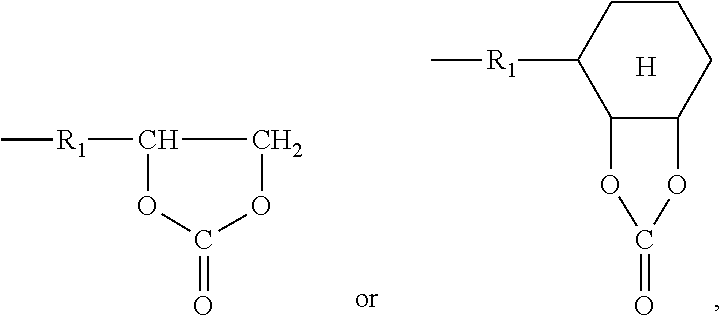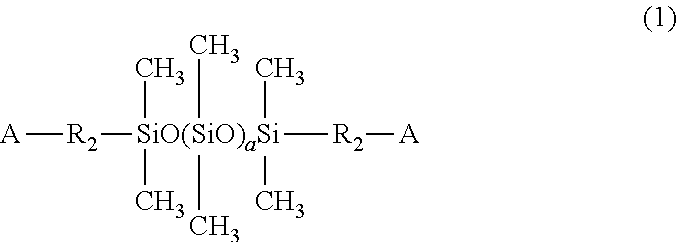Self-crosslinking polysiloxane-modified polyhydroxy polyurethane resin, resin material containing same, method for producing same, artificial leather comprising same, and thermoplastic polyolefin skin material comprising same
a technology of polyhydroxy polyurethane and polysiloxane, which is applied in the direction of synthetic resin layered products, weaving, transportation and packaging, etc., can solve the problems of increasing the cost of carbon dioxide emissions, the degradation of polyurethane resins, and the inability to meet the requirements of use, etc., to achieve excellent hand feeling and also surface scratch resistance, excellent abrasion resistance, and chemical resistance
- Summary
- Abstract
- Description
- Claims
- Application Information
AI Technical Summary
Benefits of technology
Problems solved by technology
Method used
Image
Examples
production example 1
Production of Modifier
[0103]While thoroughly stirring a 1:3 adduct of trimethylolpropane and hexamethylene diisocyanate (“COLONATE HL”, trade name, product of Nippon Polyurethane Industry Co., Ltd.; NCO: 12.9%, solids content: 75%) (100 parts) and ethyl acetate (24.5 parts) at 100° C., ε-caprolactam (25.5 parts) was added, followed by a reaction for 5 hours. According to an infrared absorption spectrum (measured by “FT-720”, HORIBA Ltd.; hereinafter equally measured) of the resulting modifier, an absorption of free isocyanate groups remained at 2,270 cm−1. Upon quantification of those free isocyanate groups, they were found to amount to 1.8% at a solids content of 50% (cf. calculated value: 2.1%). The principal structure of the above-described modifier is presumed to be represented by the following formula.
production example 2
Production of Modifier
[0104]While thoroughly stirring an adduct of hexamethylene diisocyanate and water (“DURANATE 24A-100”, trade name, product of Asahi Kasei Corporation; NCO: 23.0%) (100 parts) and ethyl acetate (132 parts) at 80° C., methyl ethyl ketoxime (32 parts) was added, followed by a reaction for 5 hours. According to an infrared absorption spectrum of the resulting modifier, an absorption of free isocyanate groups remained at 2,270 cm−1. Upon quantification of those free isocyanate groups, they were found to amount to 2.6% at a solids content of 50% (cf. calculated value: 2.9%). The principal structure of the above-described modifier is presumed to be represented by the following formula.
production example 3
Production of Modifier
[0105]While thoroughly stirring a 1:3 adduct of trimethylolpropane and tolylene diisocyanate (“COLONATE L”, trade name, product of Nippon Polyurethane Industry Co., Ltd.; NCO: 12.5%, solids content: 75%) (100 parts) and ethyl acetate (67.3 parts) at 80° C., methyl ethyl ketoxime (17.3 parts) was added, followed by a reaction for 5 hours. According to an infrared absorption spectrum of the resulting modifier, an absorption of free isocyanate groups remained at 2,270 cm−1. Upon quantification of those free isocyanate groups, they were found to amount to 2.0% at a solids content of 50% (cf. calculated value: 2.3%). The principal structure of the above-described modifier is presumed to be represented by the following formula.
PUM
| Property | Measurement | Unit |
|---|---|---|
| mass % | aaaaa | aaaaa |
| temperature | aaaaa | aaaaa |
| temperature | aaaaa | aaaaa |
Abstract
Description
Claims
Application Information
 Login to View More
Login to View More - R&D
- Intellectual Property
- Life Sciences
- Materials
- Tech Scout
- Unparalleled Data Quality
- Higher Quality Content
- 60% Fewer Hallucinations
Browse by: Latest US Patents, China's latest patents, Technical Efficacy Thesaurus, Application Domain, Technology Topic, Popular Technical Reports.
© 2025 PatSnap. All rights reserved.Legal|Privacy policy|Modern Slavery Act Transparency Statement|Sitemap|About US| Contact US: help@patsnap.com



